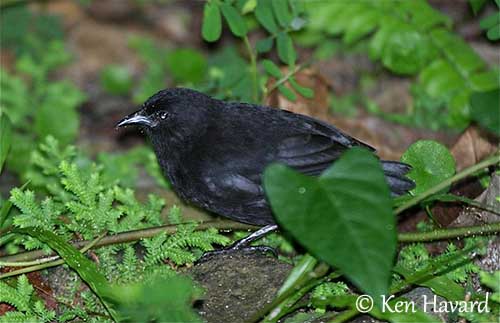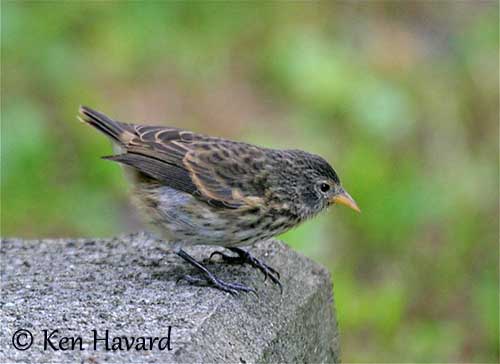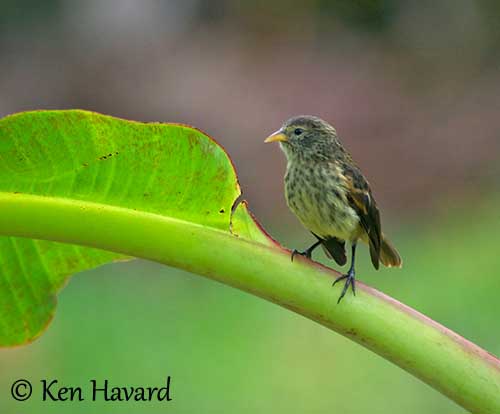
Fr: Spizin de Cocos
All: Kokosinselammer
Esp: Pinzón de Darwin de la Cocos
Esp. Costa Rica: Pinzón de la isla del coco
Ita: Fringuello del cocco
Nd: Cocosvink
Sd: Cocosfink
Photographer:
Ken Havard
My Bird Gallery & Flickr gallery 1 & Flickr gallery 2
Text by Nicole Bouglouan
Sources:
HANDBOOK OF THE BIRDS OF THE WORLD Vol 16 by Josep del Hoyo- Andrew Elliot-David Christie – Lynx Edicions – ISBN: 9788496553781
BirdLife International (BirdLife International)
Cocos Finch
Pinaroloxias inornata
Passeriformes Order – Thraupidae Family
Darwin’s Finches - Generalities
INTRODUCTION:
The Cocos Finch is the only Darwin’s Finch not native to the Galapagos Islands. It is also the only member of the genus Pinaroloxias. This species is endemic to Cocos Island, S of Costa Rica.
It frequents all habitat types on the island. It is evaluated as Vulnerable because, although to be common to abundant, it has very restricted range of about 25 km2.
DESCRIPTION OF THE BIRD:
Biometrics:
Length: 12 cm
Weight: 13-16 g
The adult male is almost entirely black, including wings and tail, but except on vent and undertail-coverts which are white with black feather centres.
It has long, narrow, finely pointed bill with curved culmen. Unlike the Galapagos Darwin’s Finches, the bill is black all year round. The eyes are dark brown to blackish. Legs and feet are black.

The female is brownish. On the upperparts, mantle and back are brown with blackish feather centres. Lower back and rump are cinnamon-brown and uniform. The tail is brown with cinnamon tips, and occasionally feathers centres too. The wings are dark brown. We can see two pale buffy-brown to cinnamon wingbars. The tertials are edged in similar colour.
The underparts are pale buff with blackish streaks on breast and flanks. Belly and vent are unstreaked and the rear flanks are darker buff.
The head is brownish and streaked, with pale buffy supercilium.
The bill is orange-yellow with dark culmen. The eyes are dark. Legs and feet are blackish.

The immature male resembles female, but it has more streaked underparts, whereas crown and upperparts are blackish-brown with less visible streaking. The bill is yellow.
RANGE:
The Cocos Finch is found on Cocos Island, S of Costa Rica.
HABITAT:
The Cocos Finch frequents every available habitat on the island, such as Hibiscus coastal thickets, woodland and open country. It also occurs in closed-canopy forest and in disturbed vegetation. The species is visible at all elevations, but it is more abundant in lowlands.
These different habitat types have involved a wide variety of feeding behaviours, in order to get food in each area.
CALLS AND SONGS:
The Cocos Finch’s calls and songs are fairly similar to those of other Darwin’s Finches.
The calls include a high-pitched “phzzzzz” and a more nasal “phheww”. We can also hear a raucous “djrr” and a whistled “tyew”.
The song consists of a buzzy double note “chz-zhweeuu” or “phfft-zheeuu”. The song is often preceded by a metallic note, and rises at the end.
BEHAVIOUR IN THE WILD:
The Cocos Finch feeds on arthropods, nectar, soft fruits, grass seeds and small lizards. This species shows individual specialization in feeding behaviour. Each bird may use one or several different foraging manners.
We can observe four main types of feeding behaviour, but there are some others:
The Cocos Finch’s wide range of foraging behaviours could indicate the absence of competition. An individual may favour particular technique, involving an individual specialization, which differs from that of another bird feeding nearby.

They are usually seen in pairs or in small groups.
During the breeding season, the males finches have been observed defending territories only in the close vicinity of the nest.
The Cocos Finch’s breeding behaviour is poorly known, but we can suggest that it is fairly similar to the courtship and nesting behaviours of the Galapagos finches, with a male singing and displaying at display-nest to attract females.
It is resident in its range, and only performs short-distance flights.
REPRODUCTION OF THIS SPECIES:
The Cocos Finch breeds throughout the year, with a peak between January and May.
The nest is typically built by the male. This is a spherical structure with a lateral entrance towards the top. It is made with grasses, twigs and dry leaves. The nest is placed at the end of a tree branch, about 2 metres above the ground.
The female lays 2 brownish eggs with white speckles. She incubates alone during 12 days. The young birds fledge 12-15 days after hatching.
PROTECTION / THREATS / STATUS:
The Cocos Finch is common to abundant throughout its restricted range. The population is suspected to be stable.
The usual threats are the introduced rats and cats. Deer (native), pigs and goats (introduced) degrade the natural habitats. The increasing tourism involves some disturbances.
But currently, none of these potential threats appear to affect the numbers (6,000/15,000 mature individuals).
However, the species is listed as Vulnerable because it has very restricted range, threatened by natural events.
The Cocos Island is a protected National park.